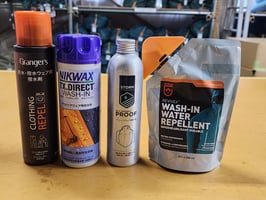For those of you who have purchased expensive outdoor jackets such as Gore-Tex jackets and have had...
Applying heat restore waterproofing performance?
You may have heard that when water is no longer repelled by umbrellas or rainwear, it can be recovered by applying heat. In fact, this story contains several misconceptions and errors.
We, as water repellent professionals, will explain the truth of this in detail.
Not waterproofing performance that is restored, but water repellency
The first point I would like to convey is that it is not the waterproofing performance that is recoverable, but the water repellency.
Aren't they both the same? You might think so, but these are distinctly different phenomena.
Waterproofing is the act of sealing the fabric's eyes to keep water out, while water repellency is the act of preventing the fabric from absorbing water.
For a detailed explanation, please refer to another article.
What is waterproofing degradation?
For example, rainwear uses fabrics such as Gore-Tex, which does not allow water to pass through, to maintain its waterproof performance.
The membrane that makes up the main body of Gore-Tex is a very stable material and its waterproofing performance does not deteriorate.
The only time it loses its waterproofing properties is when it is punctured or torn.
In the case of umbrellas, the waterproofing is maintained by coatings.
These are applied to the underside of the umbrella, and heat will not restore the waterproofing.
In fact, heat will accelerate the deterioration of the coating.
In the case of coatings, unlike membranes such as Gore-Tex, the resin responsible for waterproofing is unstable and its waterproofing performance may deteriorate over time.
Heat cannot restore it, and when a coating's waterproofing performance degrades, it is difficult to re-coat and difficult to repair.
Proper storage is important to prevent these coatings from deteriorating.
Storing in a place where air does not circulate by leaving it in something will accelerate the deterioration, so store it in a place where there is air circulation.
What is water repellency?
Water repellency, on the other hand, is the way water turns into a sphere without being absorbed by the fabric.
Water normally tries to penetrate into a mesh like fabric, but chemical forces prevent this from happening.
This water repellency does not deteriorate over time.
However, the water repellent performance will deteriorate due to the various stresses given to the material during use.
Therefore, it is necessary to restore the water repellency that has been lost due to deterioration.
At this point, water repellency restoration treatment differs depending on the cause of deterioration. Each cause of deterioration and treatment method will be explained in detail later.
Water repellent performance may be restored by heat
Unlike waterproof performance, water repellency may be restored by applying heat. However, there are conditions, and it is not always possible to recover the water repellency by applying heat.
In conclusion, the process of applying heat is not difficult, so if the water repellency is lost, the basic rule is to first try applying heat, and if it does not work, try other methods. This is explained in detail.
There are three main factors that decrease water repellency
There are actually three ways to restore water repellency, the ability to repel water.
Since which treatment is appropriate depends on the factors that reduce water repellency, we will first look at the three factors that reduce water repellency.
i) Surface contamination
Water repellency is caused by the chemical force between water and the resin coated on the surface of the fabric.This phenomenon occurs when water comes into contact with the water-repellent resin on the surface of the fabric, so if dirt gets in between the two, the water-repellent performance will not be achieved.
If the fabric is not washed properly, not only the outer surface is affected by dirt, but also the inner surface is affected by human sebum and other contaminants.
ii) Familiarity with water
In point i), I mentioned that water repellency occurs when water comes into contact with a resin that has a water-repellent component in the fabric. This "resin with water-repellent components" is a bit tricky.When you hear the word "resin," you probably imagine something solid like a block puzzle, but it is not necessarily like that.
Resin with a water-repellent component is rubbery and changeable, depending on temperature.
Therefore, if this resin is in contact with water all the time, the surface composition of the resin will change and its properties will change.
As a result, the resin gradually loses its water repellency when exposed to water.
We call this acclimation to water.
However, such acclimation does not occur when the resin is exposed to air instead of water.
Therefore, the water repellency does not deteriorate simply by storing the product without using it.
iii) Release of water-repellent components
Threads used in fabrics for outdoor wear are often very strong and difficult to break.
However, wear and tear from use and various stresses can cause some of the threads to break.
Thread is originally made up of twisted yarn, which is made up of very fine fibers, so it is not so much the thread that breaks, but rather the twisted yarn.
Water repellent coating is applied to the surface of the yarn, but unfortunately it does not coat the inside of the yarn.
Therefore, when a twisted yarn breaks, the inner surface of the yarn is exposed, and a new uncoated surface is exposed.
Of course, this is not the only case, but there are also cases where the water-repellent component does not adhere sufficiently to the yarn surface.
In some cases, simple treatments such as waterproofing sprays only ride on the yarn surface, and the water-repellent component may drop off with use.
How to deal with each of the factors that reduce water repellency
Different factors that reduce water repellency will require different countermeasures for each. As mentioned in the previous heading, applying heat may restore water repellency, but it is not sufficient.
Let's understand the appropriate remedy for each degradation factor.
i) Washing for surface dirt adhesion
In the case of surface contamination, there is an intervention called dirt between the resin applied to the fabric and the water, and the process is to remove it.This is the reason why water repellency may be restored simply by washing.
In this case, no special heat treatment is required, and simply cleaning the surface may improve water repellency.
It is important to note that water stains are easy to remove with home laundering, but there are other types of stains such as oil stains and insoluble stains.
These are more difficult to remove with home laundering and may require professional cleaning.
ii) Heat treatment for familiarity with water
If the coating has been in contact with water for a long time and has become acclimated to the water, heat treatment is effective.As mentioned in the section on causes, the resin in the coating is not solidified but rubbery, and heat will activate this resin and restore it to its original state.
Although not completely restored, water repellency can be restored to some extent by activating the resin through the application of heat.
iii) Reprocessing to release water-repellent components
If the water-repellent component is removed from the fabric, no amount of washing or heat treatment will restore the water-repellent performance.
In fact, it will cause further damage to the fabric.
Therefore, if water repellency is not restored by washing or heat treatment at home, please reprocess the water repellency.
Here, it is also important to remember that water repellent treatments that can be easily applied, such as waterproofing sprays, in other words, can easily take off.
To add durability to water repellency, a certain amount of process is required.
Therefore, the DANSUI coating is a technology developed by the author, who was dissatisfied with the use of waterproofing sprays and commercial water repellents.
Unlike waterproof sprays and commercial water repellents, this technology is not sold only as a water repellent and treated at each household, but rather a water repellent is treated at a specialized factory to bring out durable water repellent performance.
The more time and effort required, the easier it is to create a coating that adheres more firmly to the fabric.
If you have treated with waterproofing sprays or commercial water repellents and are not satisfied with the performance, please contact us.
Summary
I shared insights from an expert's point of view that applying heat restores water repellency.
While this is true in a sense, I hope you have also understood that in some cases, applying heat alone is not sufficient to understand the phenomenon.
And for each of the factors that reduce water repellency, there are different ways to deal with each of them, which we have also discussed in this article.
Finally, remember that more durable water repellent treatments are difficult to apply at home and require professional treatment.


.jpeg?height=200&name=AdobeStock_359539131_Editorial_Use_Only(1).jpeg)
.jpg?height=200&name=vol03(1).jpg)